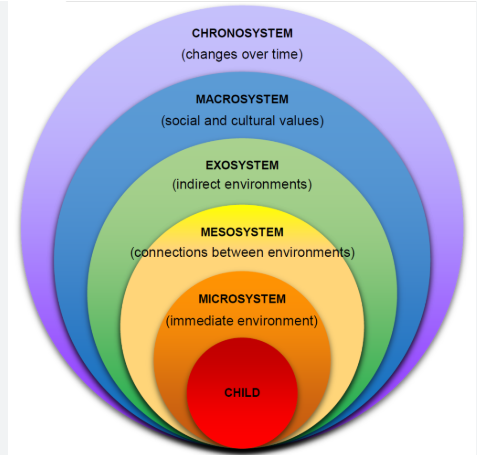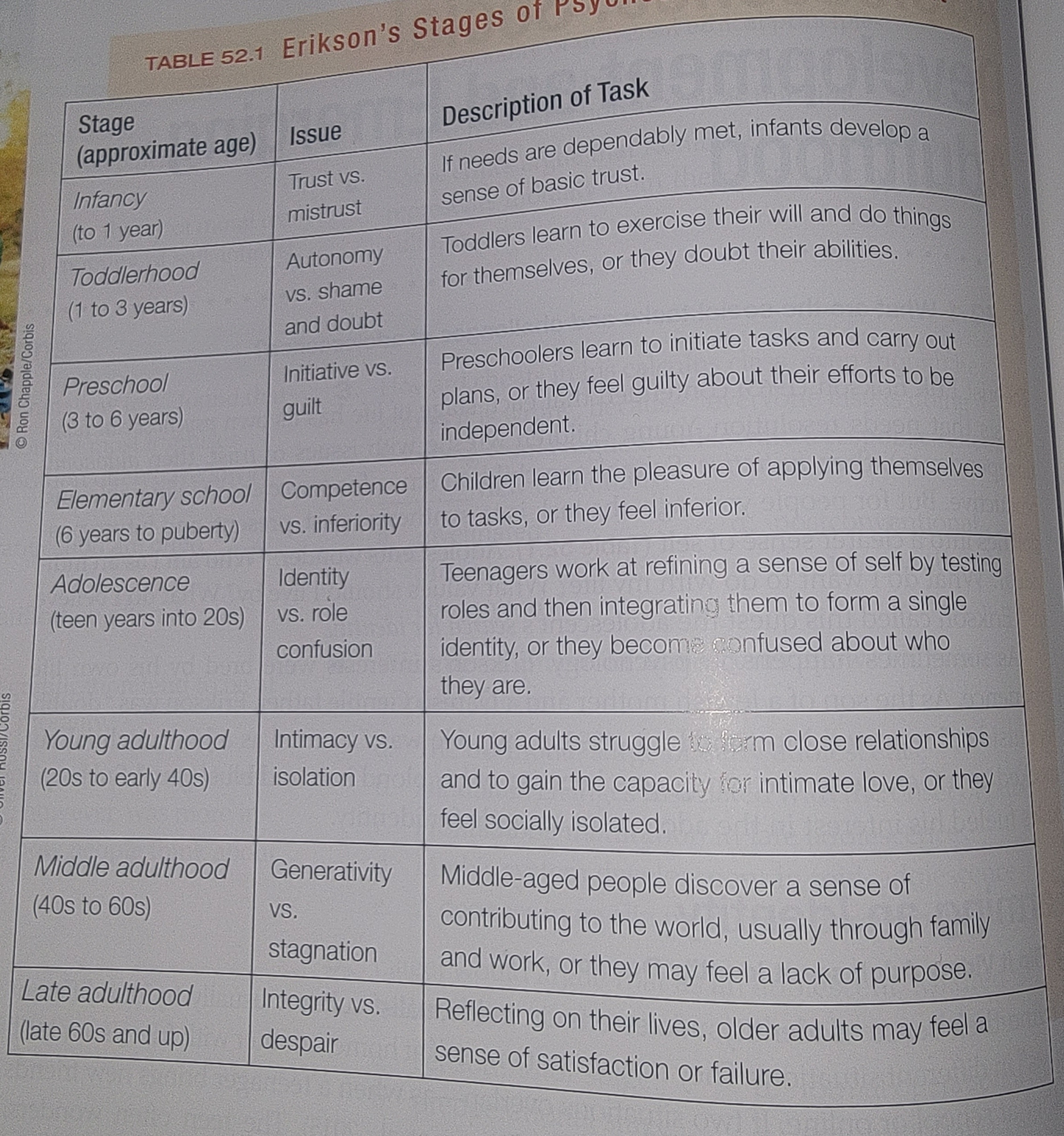3.6 Social-Emotional Development Across the Lifespan
1/14
There's no tags or description
Looks like no tags are added yet.
Name | Mastery | Learn | Test | Matching | Spaced |
|---|
No study sessions yet.
15 Terms
Ecological systems theory
explores how the social environment influences development. The five systems in this theory are:
Microsystem (groups that have direct contact with the individual) ex. friends, family, classmates, teachers
the feedback, support, and conflict that an individual experiences here have a major impact on the individual’s attitudes, beliefs, self esteem, behavior, and emotional well being
Mesosystem (the relationships between groups in the microsystem) the connections between the different people and places that are part of your daily life ex. the relationship between your parents and your friends, parents don’t approve and they may try to limit the time you have with that friend or make negative comments, which reduces the time you have with that friend, increases the tension at home, and could influence how you perceive your friends or family
Exosystem (indirect factors/influences in an individual’s life) environments or settings that an individual isn’t directly part of but still are impacted by ex. local gov cuts fund for education resulting in your district cutting funds, limiting your opportunities.You’re not part of the government or the school board but their decisions impact you ex. your parents and their workplace, they’re stressed so when they go home they are negative to you
Macrosystem(cultural events that affect the individuals and others around them) the big picture system, includes society, societal values, laws, customs, and cultural beliefs
influences all of the other systems, the cultural values of the society that an individual is part of end up shaping the different institutions and people in the previous systems
Chronosystem (the individual’s current stage of life). More abstract as it deals with time, specifically with the changes that occur throughout an individual’s life and the timeframe in which an individual lives in ex. parents getting divorced would change a person’s family dynamics ex. life transitions like middle school to high school put individuals in new environments and change their their social dynamics and influence their friendships and opportunities

Authoritarian parenting style
coercive,they impose rules and expect obedience. They produce children with less social skill and self esteem, and a brain that overreacts when they make mistakes
statements like “Don’t stay out late or you’ll be grounded”
“Why? Because I said so”
Authoritative parenting style
confrontive, they are both demanding and responsive. They exert control by setting rules, but especially with older children, they encourage open discussion and allow exceptions. They produce children with the highest self esteem, self reliance, self regulation, and social competence
Permissive parenting style
unrestraining, they make few demands, set few limits, and use little punishment. They produce children who are more aggressive and immature
Negligent parenting style
uninvolved, they are neither demanding nor responsive. They are careless,inattentive, and do not seek to have a close relationship with their children. They produce children with poor academic and social outcomes
Secure attachment style
demonstrated by infants who comfortably explore environments in the presence of their caregiver
show only temporary distress when the caregiver leaves, and find comfort in the caregiver’s return
Insecure attachment styles
demonstrated by infants who display either a clinging, anxious attachment or an avoidant attachment that resists closeness, also disorganized attachment
anxious attachment- overly dependent on their parent and show extreme distress when separated
avoidant attachment- tend to avoid or ignore their parents or caregivers, showing little emotion when their parent leaves or returns to them
disorganized attachment- often experienced inconsistent or possibly even frightening caregiving, display confusing or contradictory behaviors and can result in the child having emotional or behavioral problems
Temperament
a person’s characteristic emotional reactivity and intensity
child’s personality traits, like easy going, shy or angered easily
related to how children attach to caregivers
kids with easy temperaments are calm and adaptable, resulting in them forming secure attachments more easily
kids with difficult temperaments have larger emotional reactions and are possibly harder to soothe, possibly indicating that they are more prone to insecure attachments
Separation anxiety
when children express heightened anxiety or fear when away from a caregiver or in the presence of a stranger.
because caregivers don’t just give basic needs like food and water, but also comfort
important of comfort highlight in the monkey study
Studies with monkeys
baby monkeys had a mom made of wires that gave food, and another mom made of cloth
found that monkeys only went to wire mom for food and immediately back to cloth mom for comfort, also when scared they would immediately go to cloth mom
demonstrates the importance of comfort over food in attachment
How peer relationships develop over time
Children engage with peers via play(parallel/playing next to each other rather than directly with each other and pretend)
Adolescents gradually rely more on peer relationships as they age. As adolescents interact with peers, they demonstrate a type of egocentrism that is often demonstrated via the imaginary audience and the personal fable
egocentrism- focused on their own perspective
imaginary audience- think everyone is watching and judging them, putting themselves at the center of attention
personal fable- the belief that an individual’s experiences are unique and that no one else can fully understand what they’re going through
How adults develop socially over time
Culture plays a role in determining when adulthood begins and when major life events occur (social clock). Some cultures allow for a time of emerging adulthood as a transition from adolescence to adulthood
Social clock- the culturally preferred timing of social events such as marriage,parenthood, and retirement
Emerging adulthood- when many in Western cultures are no longer adolescents but have not yet achieved full independence as adults
Relationships with other adults result in adults forming families or family-like relationships that should provide mutual support and care. Childhood attachment styles can affect how adults form attachments to other adults.
Erikson’s Stages of Psychosocial Development
Infancy-issue: Trust vs mistrust
Toddler hood(1-3)-issue: Autonomy vs shame and doubt
Preschool(3-6)-issue: Initiative vs guilt
Elementary school(6 to puberty)-issue: Competence vs inferiority
Adolescence(teen to 20s)-issue: Identity vs role confusion
Young adulthood(20s to early 40s)-issue: Intimacy vs isolation
Middle adulthood(40s to 60s)-issue: Generativity vs stagnation
Late adulthood(late 60s and up)-issue: Integrity vs despair
The stage theory of psychosocial development, which was a reconceptualization of the psychosexual theory, proposes that people must resolve psychosocial conflicts at each stage of the lifespan

Adverse Childhood Experiences(ACE)
ACEs- stressful or traumatic events that occur during a person’s childhood, such as abuse or neglect
The experience of adverse childhood experiences (ACEs) has effects on relationships people form throughout the lifespan. Sociocultural differences exist in what is considered an ACE and how ACEs affect outcomes people may experience
Stages of Identity
achievement, diffusion, foreclosure, and moratorium
Foreclosure- high degree of commitment to a particular identity or idea
Diffusion- has not committed to a set idea or identity and has not explored any possibilities, often resulting in a lack of direction
Moratorium- actively exploring their identity and possible options, however, they do not have a commitment to one particular identity or idea just yet
Achievement- has a set identity and has explored their options, means the individual was able to come to their own conclusion about their identity and not rely on someone else’s
Adolescents develop a sense of identity for who they will be as an adult through the processes of achievement, diffusion, foreclosure, and moratorium. Identity development also includes processes for developing identities such as racial/ethnic identity, gender identity, sexual orientation, religious identity, occupational identity, and familial identity, often through considering possible selves.